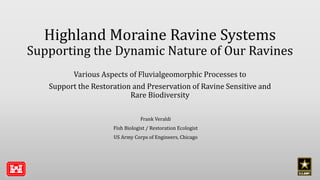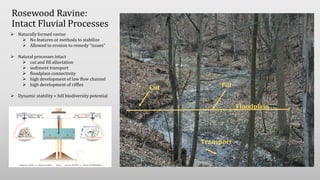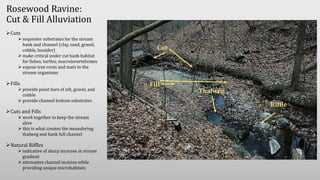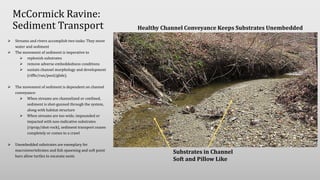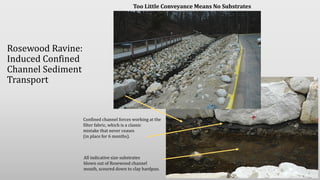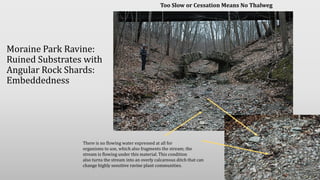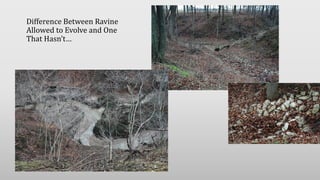Ravine Alliance
- 1. Highland Moraine Ravine Systems Supporting the Dynamic Nature of Our Ravines Various Aspects of Fluvialgeomorphic Processes to Support the Restoration and Preservation of Ravine Sensitive and Rare Biodiversity Frank Veraldi Fish Biologist / Restoration Ecologist US Army Corps of Engineers, Chicago
- 2. Rosewood Ravine: Intact Fluvial Processes Cut Fill Transport Floodplain Naturally formed ravine No features or methods to stabilize Allowed to erosion to remedy “issues” Natural processes intact cut and fill alluviation sediment transport floodplain connectivity high development of low flow channel high development of riffles Dynamic stability = full biodiversity potential
- 3. Rosewood Ravine: Cut & Fill Alluviation Cuts sequester substrates for the stream bank and channel (clay, sand, gravel, cobble, boulder) make critical under cut bank habitat for fishes, turtles, macroinvertebrates expose tree roots and mats to the stream organisms Fills provide point bars of silt, gravel, and cobble provide channel bottom substrates Cuts and Fills work together to keep the stream alive this is what creates the meandering thalweg and bank full channel Natural Riffles indicative of sharp increase in stream gradient attenuates channel incision while providing unique microhabitats Cut Fill Riffle Thalweg
- 4. Rosewood Ravine: Why Storm Water is Not A Major Concern for Habitat Sustainability All ravines within the Highland Moraine System influenced by storm water inputs Increase of water to the ravines has mimicked an increase in watershed size to about 1.5 times the actual size Channel evolution negates permanent effects: development of the floodplain allows for very small substrates to remain stable, as you can see the sandy channel The major implication for storm water is quality (chemistry) and how that affects plants and animals, not quantities for habitat
- 5. McCormick Ravine: Sediment Transport Streams and rivers accomplish two tasks: They move water and sediment The movement of sediment is imperative to replenish substrates remove adverse embeddedness conditions sustain channel morphology and development (riffle/run/pool/glide). The movement of sediment is dependent on channel conveyance: When streams are channelized or confined, sediment is shot-gunned through the system, along with habitat structure When streams are too wide, impounded or impacted with non-indicative substrates (riprap/shot-rock), sediment transport ceases completely or comes to a crawl Unembedded substrates are exemplary for macroinvertebrates and fish spawning and soft point bars allow turtles to excavate nests Healthy Channel Conveyance Keeps Substrates Unembedded Substrates in Channel Soft and Pillow Like
- 6. Rosewood Ravine: Induced Confined Channel Sediment Transport Too Little Conveyance Means No Substrates All indicative size substrates blown out of Rosewood channel mouth, scoured down to clay hardpan. Confined channel forces working at the filter fabric, which is a classic mistake that never ceases (in place for 6 months).
- 7. Moraine Park Ravine: Ruined Substrates with Angular Rock Shards: Embeddedness Too Slow or Cessation Means No Thalweg There is no flowing water expressed at all for organisms to use, which also fragments the stream; the stream is flowing under this material. This condition also turns the stream into an overly calcareous ditch that can change highly sensitive ravine plant communities.
- 8. Ravine 8:Ravine Maturity Stalled in Confined Channel Phase Ravines within the Highland Moraine system have been stopped early or mid-way through their evolution. Various reasons for this include but are not limited to: infrastructure & right-a-ways residence / homes desire to control wild systems unfounded fears of erosion misguided decisions of habitat restoration, etc. Issues come along with trying to stop a ravine in the confined channel stage of geologic evolution: 1. Forces can even rip apart traditional filter fabric with angular riprap combo 2. The head of the ravine is now static, one factor preventing ravine evolution by stopping head cutting and ultimately ravine widening 3. Check dams to prevent head cutting from the bottom, which prevents ravine evolution and connectivity 4. Operational or defunct infrastructure destroyed further adds chaos and unsightly conditions to the ravine habitats Too Fast Means No Substrates 1 2 3 4
- 9. Difference Between Ravine Allowed to Evolve and One That Hasn’t…
- 10. If Intact Fluvial Processes Were Left Alone in the Highland Moraine Ravines, Then We May See Such Stream Creatures As…
- 11. Burbot (Lota lota) would spawn in riffles/juveniles live in riffles Banded Killifish Fundulus diaphanus would live in pools, runs and mouth deltas Mottled Sculpin (Cottus bairdii) would live in riffles Chestnut Lamprey (Ichthyomyzon castaneus) would spawn in riffles, ammocoetes need unembedded sand/gravel bars to live in 3-6 years Mudpuppy (Necturus maculosus) may use pools with woody debris for spawning in spring supported by groundwater discharge in ravines Lake Chub (Couesius plumbeus) spawn and use ravine stream as rearing estuary All fish photos by Dr. Phil Willink, Ichthyologist, Shedd Aquarium
